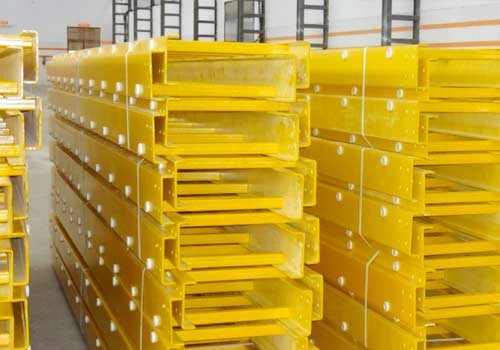
FRP cable tray is a cable management system made of glass fiber reinforced plastic (FRP) or glass reinforced plastic (GRP).FRP cable trays are designed to support cables in highly corrosive and structurally demanding environments such as offshore platforms, chemical plants, oil and metal refineries, and water treatment plants FRP cable tray has many advantages over traditional metal cable tray, such as:
Corrosion resistance: FRP cable trays can withstand exposure to various chemicals, moisture, salt spray, ultraviolet rays, and extreme temperatures without rust or deterioration.
High strength-to-weight ratio: FRP cable tray is light in weight but strong, reducing the load on the support structure and making installation easier.
High durability: FRP cable tray is impact-resistant, wear-resistant, fatigue-resistant, and fire-resistant, which can extend the service life and reduce maintenance costs.
Non-conductive and non-magnetic: The FRP cable tray will not interfere with the electrical properties of the cable or cause electromagnetic interference (EMI), improving the safety and reliability of the system.
Flexibility in design: FRP cable tray can be customized to fit various shapes, sizes, and configurations, which allows for optimal cable routing and space utilization.
FRP Cable Tray Types
There are two main types of FRP cable tray: perforated type and ladder type. Perforated type cable tray has a solid or slotted bottom that provides full ventilation and protection for the cables. Ladder type cable tray has rungs that support the cables and allow for air circulation. Both types are available in multiple resin systems, widths, lengths, and colors to suit different applications and environments.
FRP Cable Tray Installation
The installation of FRP cable tray requires proper planning, preparation, and execution to ensure a successful and safe outcome. Some general guidelines for installing FRP cable tray are:
Follow the manufacturer’s instructions and specifications for the FRP cable tray system, including the fittings, supports, and accessories.
Use appropriate tools and equipment for cutting, drilling, fastening, and lifting the FRP cable tray components.
Wear personal protective equipment (PPE) such as gloves, goggles, masks, and helmets to prevent injuries from sharp edges, dust, or falling objects.
Check the alignment, levelness, clearance, and stability of the FRP cable tray before placing the cables on it.
Secure the cables to the FRP cable tray with suitable clamps or ties to prevent sagging or movement.
Avoid overloading or exceeding the rated capacity of the FRP cable tray to prevent deformation or failure.
Conclusion
FRP cable tray is a modern and innovative solution for cable management in harsh and challenging environments. It offers many benefits over traditional metal cable trays in terms of corrosion resistance, strength-to-weight ratio, durability, electrical performance, and design flexibility. By following proper installation procedures and practices, FRP cable tray can provide a long-lasting and reliable support for electrical cables.
 +86 15303735673
+86 15303735673 Jessica@frpzs.com
Jessica@frpzs.com
 Technical Data
Technical Data











